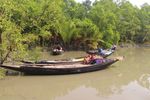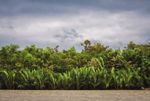MANAGEMENT OF THE SUNDARBANS MANGROVE FORESTS FOR BIODIVERSITY CONSERVATION AND INCREASED ADAPTATION TO CLIMATE CHANGE PROJECT (SMP) - GIZ
←
→
Page content transcription
If your browser does not render page correctly, please read the page content below
Management of the Sundarbans
Mangrove Forests for Biodiversity
Conservation and Increased Adaptation
to Climate Change Project (SMP)
Implemented by:PROJECT BACKGROUND
The German Federal Ministry
The Sundarbans constitute the world’s largest continuous mangrove COMMISSIONED
for Economic Cooperation and
forest (10,000km2) located within a massive river delta system between BY
Development (BMZ)
India and Bangladesh. The Bangladesh Sundarbans Mangrove Forest
(SMF), covering an area of 6,017km2, is protected through restricting Bangladesh Ministry of
resource use and access rights to varying degrees. The SMF plays a Environment and Forests
crucial role as buffer between land and sea, as well as as a protective IMPLEMENTING (MoEF), Bangladesh Forest
wall against tropical cyclones. Against the background of progressing AGENCIES Department (BFD), and the
climate change, the Sundarbans ecosystem is even more important for Deutsche Gesellschaft für
the people living in its periphery. Due to its inaccessibility, unique and Internationale
globally important biodiversity has remained preserved and the Zusammenarbeit (GIZ) GmbH
Sundarbans have been declared a UNESCO World Heritage Site.
Field implementation in
There are no permanent settlements inside the SMF. However, a large
PROJECT AREA Bagerhat, Satkhira, and Khulna
number of people living in its periphery depend on the mangrove
Districts as well as policy
ecosystem for their livelihood: People enter the forest – some legally
advisory at the national level
some illegally - to harvest natural resources including fish, nypa palm
and honey. On a larger scale, the SMF plays an indispensable role as DURATION May 2015 to April 2019
breeding and nursery ground for economically important fish species
in the rivers and the Bay of Bengal supporting income generation and Rural population with strong
food security far beyond the direct boundaries of the forest. TARGET GROUP dependency on Sundarbans
The SMF ecosystem and its biodiversity are subject to multiple resources and BFD staffs
stressors, including unsustainable use of natural resources. The
Bangladesh Forest Department (BFD) is the official custodian of the
SMF and responsible for its protection. Challenges related to technical
capacities, financial resources, and institutional
arrangements currently hamper the BFD’s efforts to
effectively address these stressors in the management of
the SMF.
Through co-management structures at the village and
Upazila / sub-district levels, local communities are given a
platform to participate in the management of the SMF.
Different actors, including governmental agencies, donors
and NGOs, are involved in conservation and management
of the SMF as well as community development in the
periphery. Improved coordination between relevant
actors to leverage synergies would greatly increase the
impact of conservation and management of the SMF.
Also, co-management structures are yet to sufficiently
facilitate participation of resource users in decision
making about the SMF.
GIZ supports the BFD in strengthening its management
capacities, empowering co-management structures, and
developing institutional mechanisms towards increased
coordination.
Management of the Sundarbans Mangrove Forests for Biodiversity Conservation and Increased Adaptation to Climate Change Project (SMP)PROJECT OBJECTIVE
Government agencies at the national and local level, that are
responsible for the management of the Sundarbans, as well as
co-management structures, have implemented mechanisms
that improve the management of the SMF.
INTERVENTION AREAS
The project follows a multi-level approach. Experiences
gathered at local level feed into policy formulation and
institutional development at district and national level.
Area 1: Enhancing coordination among relevant
actors
The BFD as the responsible agency for the SMF has the lead in Area 3: Strengthening the capacity of the BFD for
coordinating actors and measures implemented in the field. By management and conservation of the Sundarbans
establishing institutional mechanisms and further building
capacities of the BFD, cooperation and coordination among SMP further develops conservation tools and mechanisms to
different govermnment agencies, donors, and development improve the management of the SMF. As a part of this, capacity
partners is enhanced and institutionalized. building of BFD frontline staff on technical topics such as
bio-monitoring, law enforcement and co-managemnt of natural
resources, enables them to effectively use the newly developed
Area 2: Improving participation of resource users in tools. Furtehrmore, SMP supports the BFD in developing and
co-management implementing steps towards further integration of
Sustainable management of the SMF is only possible by co-management in their existing structures.
considering the needs and rights of the people depending on it.
Therefore, resource users are empowered to better voice their SMP has a special focus on gender: The project activities
concerns within the existing co-management structures and strengthen women rights for access to natural resources and to
participate in decision making processes. Institutional and the benefits derived from them.
policy development helps to sustain these processes on the
long term.
Management of the Sundarbans Mangrove Forests for Biodiversity Conservation and Increased Adaptation to Climate Change Project (SMP)Selected Achievements
SMP in collaboration with the Wildlife Conservation
Society (WCS) and other relevant actors such as
USAID and the World Bank supports capacity
building of the BFD for the Spatial Monitoring and
Reporting Tool (SMART). SMART provides the BFD
the tools to better plan, evaluate and implement
effective law enforcement and bio-monitoring. By
developing a joint data model and standard operating
procedures, SMART has been embedded in the
management structures of the BFD. Bangladesh is one
of the first countries to pilot SMART in a UNESCO
World Heritage Site.
© GIZ BD/Manzura Khan
SMP conducted a participatory governance
assessment for (co-)management of the SMF
involving more than 150 participants from
government agencies and civil society. Strengths and
challenges related to six core principles of good
As part of this, SMP is conducting a comprehensive household survey in
governance (effective participation, fair sharing of
Chadpai range covering 37 villages. The findings will be used to design a set
benefits, law enforcement, accountability, policy
of capacity development measures for local community memebrs to
coordination, and achievement of conservation
strengthen their participation in co-management. The formation of
objectives) were identified and were fed into the
dedicated resource user groups and women groups under the umbrella of
design of the measures under this component.
the existing co-management structures, is another step to improve
In cooperation with the local NGO Center for
organizational structures for co-management in the SMF.
Natural Resource Studies (CNRS) SMP supports
co-management structures with a focus on
empowering resource users and women.
Published by:
Management of the Sundarbans Mangrove Forests for For further information please contact:
Biodiversity Conservation and Increased Adaptation to
Climate Change (SMP) Mr. Md. Amir Hosain Chowdhury
Conservator of Forests, Khulna Circle
Deutsche Gesellschaft für Bangladesh Forest Department
Internationale Zusammenarbeit (GIZ) GmbH Bana Bhaban, Boyra, Khulna 9000
E-Mail: amirhdfo@yahoo.com
Registered offices
Bonn and Eschborn, Germany Mr. Oemar Idoe
GIZ Office Dhaka, Bangladesh Principal Advisor SMP
E-mail: oemar.idoe@giz.de
T + 880 (0) 966 6701 000 I www.giz.de/en/worldwide/37949.html
T +880 2 5505 1931 – 7 I www.snrd-asia.org/management-of-the-
F +88 02 5505 1938 sundarbans-mangrove-forests-for-biodiversity-conser
I www.giz.de/bangladesh vation-and-increased-adaptation-to-climate-change-
smp/
Design & Print: Color Horizon, Dhaka Photo credit:
Cover: GIZ BD / Fahad Kaizer
1: GIZ BD / Mahmud Hassan Tuhin
2: GIZ BD / Fahad Kaizer
3: GIZ DE / Barbara Lang
4: GIZ BD / Mostofa Omar Sharif
5: GIZ BD / Fahad Kaizer
Last updated: September , 2017You can also read























































